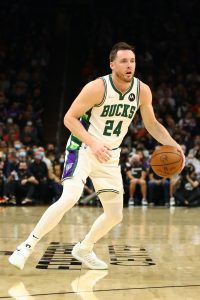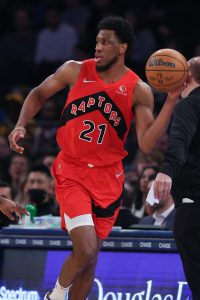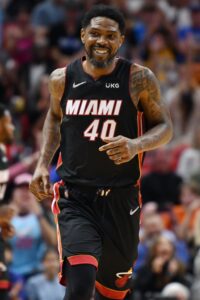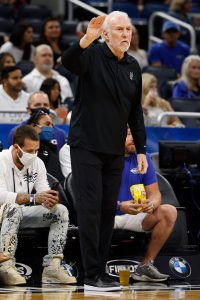An NBA team that want to re-sign a player before he reaches free agency can do so, but only at certain times and if his contract meets specific criteria.
Rookie scale extensions, which can be completed for former first-round picks between the third and fourth years of their rookie scale contracts, were the NBA’s most common form of extension in the past. But in its 2017 Collective Bargaining Agreement, the league relaxed its criteria for veteran extensions, resulting in a significant increase in those deals in recent years. They’ve now overtaken rookie scale extensions as the league’s most frequently signed extensions.
[RELATED: 2022/23 NBA Contract Extension Tracker]
A veteran extension is any contract extension that tacks additional years onto a contract that wasn’t a rookie scale deal. Even if the player is still on his first NBA contract, he can technically receive a “veteran” extension if he was initially signed as a second-round pick or an undrafted free agent rather than via the league’s rookie scale for first-rounders.
Here’s a full breakdown of how players become eligible to sign veteran extensions, and the limits that come along with them:
When can a player sign a veteran contract extension?
A team that wants to sign a player to a veteran extension wouldn’t be able to simply complete that extension one year after the initial contract was signed. The team must wait a specified period of time before the player becomes extension-eligible, as follows:
- If the player initially signed a three- or four-year contract: Second anniversary of signing date.
- Note: The second anniversary date also applies if the player previously signed an extension that lengthened his contract to three or four total seasons.
- If the player initially signed a five- or six-year contract: Third anniversary of signing date.
- Note: The third anniversary date also applies if the player previously signed an extension that lengthened his contract to five or six total seasons.
- If the player previously renegotiated his contract and increased his salary by more than 10%: Third anniversary of renegotiation date.
This set of rules has been complicated in recent years by the COVID-19 pandemic that forced the NBA to adjust its usual calendar during the 2019/20, ’20/21 and ’21/22 league years. For instance, the 2020 free agency period was delayed until November 21 instead of beginning on July 1.
 Due to that delay, Pat Connaughton signed a three-year free agent contract on November 23, 2020, which would normally make him ineligible to be extended until November 23, 2022. However, the NBA adjusted that two-year waiting period to better reflect certain stages of the offseason rather than adhering to specific dates on the calendar.
Due to that delay, Pat Connaughton signed a three-year free agent contract on November 23, 2020, which would normally make him ineligible to be extended until November 23, 2022. However, the NBA adjusted that two-year waiting period to better reflect certain stages of the offseason rather than adhering to specific dates on the calendar.
As a result, Connaughton was able to sign a new extension with the Bucks this year on July 18. Similarly, Lakers star LeBron James became extension-eligible on August 4 this year after signing his previous extension on December 3, 2020.
Going forward, the usual two- and three-year waiting periods will once again apply. For instance, after signing a four-year extension on July 6, 2022 that lengthened his contract to six total seasons, Devin Booker will become extension-eligible again on July 6, 2025. Connaughton, whose new three-year extension lengthened his contract to four total seasons, will be eligible to sign another extension on July 18, 2024.
How many years can a player receive on a veteran extension?
A veteran extension can be for up to five years, including the year(s) remaining on the previous contract. The current league year always counts as one of those five years, even if an extension is agreed to as late as June 30.
For instance, when John Konchar signed an extension earlier this summer with the Grizzlies, he had two years left on his current contract, which ran through 2023/24. He added three extra years via the extension, maxing out at five years overall.
If a player signs a “designated” veteran extension, he can receive up to six total years, as we cover in a separate glossary entry. Booker, Karl-Anthony Towns, and Nikola Jokic have all taken this route during the 2022 offseason after meeting the super-max criteria.
How much money can a player receive on a veteran extension?
The first-year salary in a veteran extension can be worth up to 120% of the salary in the final year of the player’s previous contract or 120% of the NBA’s estimated average salary, whichever is greater. Annual raises are limited to 8% of the first-year extension salary.
When Terry Rozier signed an extension with the Hornets a year ago, he added four extra years to the one year and $17,905,263 remaining on his previous deal. Because that $17.9MM cap hit greatly exceeds the league’s estimated average salary, Rozier was eligible to earn up to 120% of his final-year salary in the first year of his extension. As such, his new contract begins this season with a salary of $21,486,316, with 8% annual raises from there.
Dorian Finney-Smith, on the other hand, was only earning $4,000,000 when he signed an extension with the Mavericks in February. A 20% raise on that amount wouldn’t have been worth Finney-Smith’s while, but he was eligible to receive 120% of the NBA’s estimated average salary, which was $10,335,000 in 2021/22. As a result, Finney-Smith’s four-year extension with Dallas begins this season at $12,402,000.
In 2022/23, the NBA’s estimated average salary is $10,792,000, so an extension-eligible player earning less than that amount – such as Pelicans big man Larry Nance Jr. – would be able to sign an extension with a starting salary of up to $12,950,400.
A contract extension can’t exceed the maximum salary that a player is eligible to earn, so there are some instances in which a player won’t be able to get a full 20% raise on a new extension.
For instance, James’ new two-year extension is technically a maximum-salary contract, but his cap hit is this season is $44,474,988, which already exceeds the standard league-wide max. A full 120% raise on that figure would be $53,369,986, which will almost certainly exceed his maximum possible salary for 2023/24. The salary cap would have to increase to approximately $152.5MM for a raise of that size to be permitted, and currently the cap is only projected for $133MM.
Because a player’s own personal maximum salary on an extension is always at least 5% of his previous salary, James is assured of at least a 5% raise to $46,698,737 in the first year of his new deal. If the cap lands beyond its current $133MM projection, James’ raise could end up between 5% and 20%, since he’d be eligible for a starting salary worth 35% of next season’s cap.
Designated veteran extensions and renegotiated contracts have slightly different rules for salaries and raises than standard veteran extensions. You can read about those differences in our glossary entries on those subjects.
Can a player sign a veteran extension as part of a trade?
The NBA’s Collective Bargaining Agreement does allow for extend-and-trade transactions, but the rules governing them are more limiting than for standard veteran extensions.
A player eligible for an extension can sign one in conjunction with a trade, but he would be limited to three overall years and a starting salary worth 105% of the final-year salary on his previous deal. Subsequent annual raises are limited to 5% as well.
A player who receives an extension that exceeds those extend-and-trade limits becomes ineligible to be traded for six months. Conversely, a player who is involved in a trade becomes ineligible to sign an extension for six months if the extension would exceed the extend-and-trade limits.
 Thaddeus Young‘s two-year extension with the Raptors is an example of a recent extension that didn’t exceed the extend-and-trade limits — he took a pay cut from $14,190,000 to $8,000,000 and the deal lengthened his contract to three total years. Because that extension fell within the extend-and-trade parameters, Young could be dealt this month if Toronto wanted to do so.
Thaddeus Young‘s two-year extension with the Raptors is an example of a recent extension that didn’t exceed the extend-and-trade limits — he took a pay cut from $14,190,000 to $8,000,000 and the deal lengthened his contract to three total years. Because that extension fell within the extend-and-trade parameters, Young could be dealt this month if Toronto wanted to do so.
Conversely, even though James’ new extension only covers three total years and will only start at 105% of his previous salary (assuming the current cap projection of $133MM is accurate), it exceeds the extend-and-trade limits by virtue of the 8% raise he’ll receive between the 2023/24 and ’24/25 seasons. As a result, he’s ineligible to be traded until February 18, which will almost certainly be after the 2023 trade deadline has passed.
An extension-eligible player can’t be extended-and-traded between the end of the season and June 30 if there’s a chance he could become a free agent that July. That rule applies to both veterans on expiring contracts and veterans with team or player options that have yet to be exercised.
For example, while Young is eligible to be traded now by the Raptors, he couldn’t have been dealt in conjunction with his extension in June.
What are the other rules related to veteran extensions?
There are many more minor rules and guidelines related to veteran extensions, including several involving bonuses and option years. A full breakdown can be found in Larry Coon’s CBA FAQ, but here are some of the notable ones most likely to come into play:
- A contract with an option can be extended if the player opts in or the team picks up the option.
- A contract with an option can also be extended if the option is declined, as long as the extension adds at least two new years to the deal and the first-year salary isn’t worth less than the option would have been. The only exception to this rule involves an early termination option — a contract with an ETO can’t be extended if the ETO is exercised, ending the contract early.
- A newly-signed extension can contain a player or team option, but not an early termination option.
- If a contract contains incentive bonuses, a veteran extension must contain the same bonuses. The bonus amounts can be increased or decreased by up to 8%, but they must still be part of the deal. An extension also can’t contain bonuses that weren’t part of the original contract.
- If a contract includes an unearned trade bonus, it doesn’t necessarily have to be applied to the extension. If the team and player elect not to carry over the trade bonus to the extension and the player is dealt before the extension takes effect, the application of the bonus would ignore the extension.
Note: This is a Hoops Rumors Glossary entry. Our glossary posts will explain specific rules relating to trades, free agency, or other aspects of the NBA’s Collective Bargaining Agreement. Larry Coon’s CBA FAQ was used in the creation of this post.
A previous version of this post was published in 2019.

 Sam Presti, Thunder (GM/executive VP): June 7, 2007
Sam Presti, Thunder (GM/executive VP): June 7, 2007 Due to that delay,
Due to that delay, 
